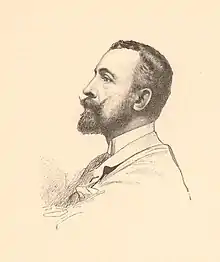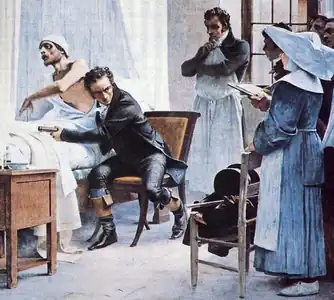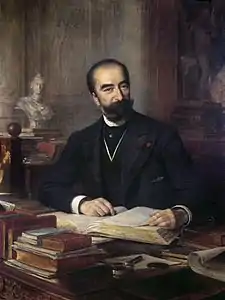Théobald Chartran | |
|---|---|
 Théobald Chartran | |
| Born | 20 July 1849 |
| Died | 16 July 1907 (aged 57) Paris, France |
| Nationality | French |
| Education | Alexandre Cabanel École des Beaux-Arts |
| Known for | Painting |
| Awards | Prix de Rome |
Théobald Chartran (20 July 1849 – 16 July 1907) was a classical French academic painter and portrait artist.
Early life
Chartran was born in Besançon, France on 20 July 1849. His father was Councilor at the Court of Appeals and he was the nephew of Gen. Chartran who was executed in the Restoration because of his imperialistic tendencies. Through his mother, he was descended from Count Théobald Dillon,[1] who was murdered by his own troops in 1792.[2]
While his parents encouraged him to study law or enter the military, young Chartran was inclined towards art. He studied at the Lycée Victor-Hugo in Besançon before heading to Paris in order to devote himself entirely to the study of art under Alexandre Cabanel,[2] later attending the École des Beaux-Arts in Paris.[3]
Career

In 1871, the body of Georges Darboy, the Archbishop of Paris, "who had perished in the disorders of the commune", was exhumed in order to receive the last honors, and Chartran made a portrait of the Archbishop in his official robes and on his catafalque. This painting was widely admired by the public and for it, he won the Grand Prix de Rome in 1877.[2]
As "T", he was one of the artists responsible for occasional caricatures of Vanity Fair magazine, specializing in French and Italian subjects. His work for Vanity Fair included Pope Leo XIII, Giuseppe Garibaldi, Umberto I of Italy, William Henry Waddington, all in 1878, Charles Gounod, Giuseppe Verdi, Ernest Renan, Jules Grévy, Napoléon Joseph Charles Paul Bonaparte, Victor Hugo, Marshal MacMahon, Granier de Cassagnac, Louis Blanc, and Alexandre Dumas fils, all in 1879.
Among Chartran's work is his portrait of René-Théophile-Hyacinthe Laennec, the inventor of the stethoscope, Gen. Gouverneur K. Warren, Benoît-Constant Coquelin, the Maharaja of Kapurthala and the Countess of Maupeou.[4] His individual-subject portraiture is often characterized by a rich background gradient, embodied in Emma Calvé as Carmen (1894).[5]
President Roosevelt
%252C_by_Theobald_Chartran.jpg.webp)
In 1899, Henry Clay Frick commissioned Chartran to create a painting of the scene when the peace protocol at the close of the Spanish–American War was signed in the Cabinet Room.[6] In October 1903, Frick gifted the picture, which had cost $20,000, to the United States, which President Roosevelt accepted.[7]
In 1902, Chartran was commissioned to paint President Theodore Roosevelt's official portrait after successfully completing portraits of Mrs. Roosevelt in 1902 and Alice Roosevelt in 1901.[8] In discussing his experience with painting the president to Le Figaro, he said that it "was difficult to get the President to sit still. I never had a more restless or more charming sitter. He speaks French like a boulevardier, and wittily." Chartran "did not try to depict the official Roosevelt, but rather the private man."[9] When Roosevelt saw the final product he hated it and hid it in the darkest corner of the White House.[10] When family members called it the "Mewing Cat" for making him look so harmless, he had it destroyed and hired John Singer Sargent to paint a more masculine portrait.[11]
Gallery
 René Laënnec – National Library of Medicine, Bethesda, Maryland, USA
René Laënnec – National Library of Medicine, Bethesda, Maryland, USA Edith Roosevelt's official portrait as First Lady (1902)
Edith Roosevelt's official portrait as First Lady (1902) Théobald Chartran – Washington A. Roebling – Brooklyn Museum
Théobald Chartran – Washington A. Roebling – Brooklyn Museum Madame Collas et sa fille, 1903, Paris, Musée d'Orsay.
Madame Collas et sa fille, 1903, Paris, Musée d'Orsay. Portrait de Sadi Carnot.
Portrait de Sadi Carnot. Cardinal James Gibbons (1904), National Portrait Gallery
Cardinal James Gibbons (1904), National Portrait Gallery
Personal life

Chartran was married to a woman who "descended from a famous family" and was "gifted with a voice of sweetness and considerable power and possessed of strong lyric ambition, which, however, she did not gratify by a career on the stage."[2] Her portrait appeared in The Pall Mall Magazine in 1906.[12]
In September 1900, Chartran acquired the Île de Salagnon (also known as "Swan Island"), one of the five islands on Lake Geneva, located between Vevey and Montreux.[13] On the island, he had a Florentine villa built by architect Louis Villard, as well as a small port. There, Chartran organized sumptuous evenings with illustrious characters and fireworks. When he died, the island was taken over by a Russian count, a Zurich merchant, and then an American, Mary Shillito. Today it is known as Villa Salagnon.[14]
His wife died just before his last visit to America in January 1906. Chartran died in Paris on 16 July 1907.[2]
See also
References
- ↑ "Dillon, Théobald Hyacinthe [known as Chevalier Dillon] (1745–1792), army officer in the French service". Oxford Dictionary of National Biography (online ed.). Oxford University Press. 2004. doi:10.1093/ref:odnb/7664. ISBN 978-0-19-861412-8. Retrieved 16 April 2021. (Subscription or UK public library membership required.)
- 1 2 3 4 5 "THEOBALD CHARTRAN DEAD. He Painted Portraits of President and Mrs. Roosevelt, Pope Pius and Cardinal Gibbons". The Boston Globe. 17 July 1907. p. 5. Retrieved 16 April 2021.
- ↑ "Théobald Chartran ('T')". www.npg.org.uk. National Portrait Gallery, London. Retrieved 16 April 2021.
- ↑ "M. CHARTRAN HERE AGAIN.; Will Paint Some Portraits but Not Miss Roosevelt in Her Wedding Dress". The New York Times. 15 January 1906. Retrieved 16 April 2021.
- ↑ "Emma Calvé as Carmen". www.clarkart.edu. Retrieved 2023-06-15.
- ↑ "PICTURE FOR WHITE HOUSE.; M. Chartran's Commission from Mr. Frick Executed -- Represents Signing of the Spanish Peace Protocol". The New York Times. 5 December 1899. Retrieved 16 April 2021.
- ↑ Times, Special to The New York (27 October 1903). "GIFT TO THE WHITE HOUSE; Historical Painting by Chartran Presented by H.C. Frick. It Represents the Signature of the Peace Protocol at the Close of the War with Spain". The New York Times. Retrieved 16 April 2021.
- ↑ "FRENCH PAINTERS HERE.; M. Chartran to Paint the President's Portrait -- M. Parent Gets a Dis- agreeable Surprise". The New York Times. 4 January 1903. Retrieved 16 April 2021.
- ↑ "ARTIST'S VIEW OF ROOSEVELT.; Theobald Chartran Says He Never Had "a More Restless or More Charming Sitter."". The New York Times. 25 April 1903. Retrieved 16 April 2021.
- ↑ Barber, J.; Verone, A. (1998). Theodore Roosevelt, Icon of the American Century. National Portrait Gallery, Smithsonian Institution. p. 50. ISBN 978-0-295-97753-9. Retrieved January 30, 2018.
- ↑ "PAINTING THE PRESIDENT'S PORTRAIT; Orlando Rouland Spends two Weeks in the Executive Office Sketching Mr Roosevelt as He Conducts the Nation's Business; Then a Week in the Green Room with the President on the Model Stand in Consultation with Cabinet Officers and Ministers". The New York Times. 10 February 1907. Retrieved 16 April 2021.
- ↑ The Pall Mall Magazine. George Routledge & Sons, Limited. 1906. p. 45. Retrieved 16 April 2021.
- ↑ "THEOBALD CHARTRAN". New-York Tribune. 18 July 1907. p. 7. Retrieved 16 April 2021.
- ↑ "Natural site - SALAGNON ISLAND - Montreux". www.petitfute.co.uk. Retrieved 16 April 2021.